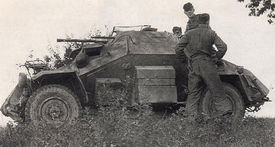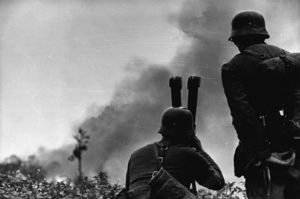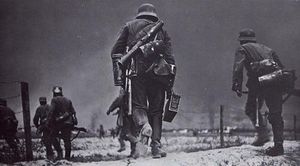Battle of Grünberg
| Battle of Grünberg | |||||||
|---|---|---|---|---|---|---|---|
| Part of 10 Days War | |||||||
A Rotgeheiman soldier and a Northern Prussian soldier of the 24th VS-Panzergrenadier Division Maria Theresia peer through a periscope at the burning outskirts of Grünberg immediately following the conclusion of the battle. |
|||||||
|
|||||||
| Belligerents | |||||||
| Porant | |||||||
| Commanders and leaders | |||||||
| Unknown | ||||||
| Units involved | |||||||
| Unknown Infantry Division |
|||||||
| Strength | |||||||
| 68,714 troops 80 tanks | 20,000 troops 20 tanks |
||||||
| Casualties and losses | |||||||
| Dead: 104 | Dead: 1,300 |
||||||
The Battle of Grünberg was a military engagement between the forces of the Rotgeheiman Verteidigungsstaffel and the army of Porant that took place from 24 January to 25 January 1913. While the small town was being assaulted by troops of the XIV VS-Panzerkorps, two concurrent engagements were being fought in Elssler and Neuhäusser, which were 10 km to the south-east and 18 km to the east, respectively. This town was one of three that was to be taken before Rotgeheiman troops could advance further.
Background
Rotgeheiman Preparations
Following the capture of Widerhausen on 24 January, the troops of the XIV VS-Panzerkorps, XII VS-Panzerkorps, and II VS-Panzerkorps were required to seize the next three objectives. The small towns of Grünberg, Elssler, and Neuhäusser were the objectives to be taken. The XII VS-Panzerkorps was assigned to attack Neuhäusser, and the II VS-Panzerkorps to attack Elssler, leaving Grünberg to be taken by the XIV VS-Panzerkorps. The capture of the three key towns would form a semi-circle around the Porantan beachhead, entrapping their land forces and preventing any further incursions by Porantan forces deeper into Hundermenschen.
Porantan Preparations
Grünberg was an essential front line defense post since the loss of Widerhausen. The town itself had been fortified with a small network of trenches running around the city, and most streets had makeshift barricades blocking access. A full Porantan infantry division was assigned to the defense of the town, but retreating Porantan troops from other battlegrounds meant that a little over a full division was present. Also taking part in the defense were three fighter planes that managed to evacuate from Widerhausen and around 20 tanks of various Porantan armored units. Porantan units fortified themselves and were reported by all field commanders as fully ready by evening of 21 January.
Initial Advance of the XIV VS-Panzerkorps
Departure from Widerhausen
As per the plan, the entirety of the XIV VS-Panzerkorps began to depart Widerhausen around 5:30 a.m. on 24 January. The 24th VS-Panzergrenadier Division Maria Theresia spearheaded the advance towards Grünberg, with 17th VS-Panzergrenadier Division Furtwängler and 27th VS-Panzer Division Finnmarck trailing a few kilometers behind. Most of the Panzerkorps followed one of two roads towards the town, although the narrowness of the path did not allow for speedy transportation, resulting in many armored vehicles driving through the fields alongside the road.
Reconnaissance units were dispatched around 6:00 a.m. to the front of the advance to scout out Porantan positions, but found none. These units were ordered to continue searching until the close of the hour. Because Grünberg was the farthest objective out from Widerhausen, it was not expected that Porantan forces were to be encountered for some time.
First Contact
The first unit to come under fire from Porantan forces was a reconnaissance detachment from the 1st Panzergrenadier Battalion, 24th VS-Panzergrenadier Division Maria Theresia. A few armored cars of the detachment
The Battle
Arrival of the 27th VS-Panzer Division Finnmarck
At about 7:05 the lead armored and mechanized infantry units of Finnmarck began to trickle in the battle space. The battered reconnaissance unit pulled out of the area shortly after with only a few wounded. The armor of the newly-arrived Panzer Division immediately began engaging the defending Porantan infantry, primarily in the buildings in the outskirts of Grünberg. Property damage was heavy due to the voluminous fire upon the Porantan troops within the structures being fired upon by the PzKmpf IX Panthera tanks.
Mechanized infantry accompanied the advancing armor. The first lines of trenches were quickly and efficiently overrun by the attacking Rotgeheiman forces. Retreating Porantan troops scrambled for cover across the open land between trenches, suffering heavy casualties. Brutal hand-to-hand combat ensued between Rotgeheiman and Porantan soldiers during the engagements in the trenches.
Rotgeheiman Air Supremacy
After pushing Porantan forces back from the first trench, Rotgeheiman forces utilized the armor as cover to pour reinforcements into the newly-taken area. Around 7:30 a.m. fighters from the 12th Fighter Wing Heftige Haie circled overhead. The three Porantan fighters were rushed into the air, but subsequently shot down. Ground attack aircraft of the 22nd Ground Attack Wing Tod von oben strafed the defending Porantan troops within the trenches, along with their support vehicles and few tanks that were firing upon Rotgeheiman infantry and armor (by the end of the battle the strafing on Porantan armor accounted for 75% of all armor kills).
Reinforcements
By 7:45 a.m. the rest of the XIV VS-Panzerkorps had arrived. The large number of reinforcements in terms of both armor and infantry meant that a new strategy for attacking the defenders in Grünberg. A two-pronged attack was envisioned and implemented. The plan was as follows:
- The 24th VS-Panzergrenadier Division Maria Theresia, supported by the 17th VS-Panzergrenadier Division Furtwängler, was to attack the defenses of Grünberg northward, taking the trenches and securing (or constructing) a path for the armored vehicles to advance directly into the town itself.
- The 27th VS-Panzer Division Finnmarck was tasked with flanking the defending troops by swinging left around the town in a quick manner, and assaulting the town from behind. This move would expose the weak rear of the defending troops and allow a swift defeat of the defending forces.
Renewed Offensive
The 24th and 17th VS-Panzergrenadier Divisions advanced headlong in the defensive positions of the Porantan forces. A few tanks (some part of the tank complement in each Panzergrenadier division, some borrowed from the 27th VS-Panzer Divsion itself) escorted the advancing infantry. Rotgeheiman troops quickly overran the subsequent lines of defense directly in front of the town. The most dangerous threat to advancing Rotgeheiman forces laid in the machine-gun nests hidden within buildings, rather any aspect of the trenches themselves. All trenches in a narrow semi-circle were captured by 9:00 a.m. The final trench was still about a hundred meters away from the town itself, requiring Rotgeheiman infantry to advance across a field and into the Grünberg. The troops succeeded in crossing (with the help of the accompanying armor) and continued to engage the defending forces in the city itself. The armored vehicles, however, were unable to provide support due to the massive roadblocks.The tank advance of Finnmarck was just as successful as the advance of its two partner divisions. The armor fired while quickly looping around the defenders, claiming a few tank kills and destroying buildings occupied by Porantan troops along the way. At least two PzKpfw XI Panthera tanks were damaged, but the recovery vehicles arrived in time to rescue the machines; unfortunately, however, one of the tanks was a write-off. The other tanks advanced speedily to the rear of the Porantan garrison and plunged deep into its weakest area. Porantan soldiers were caught off guard and were forced to flee deeper into interior of the city. Rotgeheiman troops from the 17th VS-Panzergrenadier and 24th VS-Panzergrenadier Divisions were already locked in combat in the center of the city and had managed to nearly encircle the Porantan troops there - the addition of the troops of the 27th VS-Panzer allowed for this encirclement to be completed. Forces from the contingent of troops from the 17th and 24th VS-Panzergrenadier Divisions linked up with the 27th VS-Panzer Division around noon.
Most of the remaining Porantan troops were forced into a small area a little larger than a block in interior of Grünberg. StuG VI assault guns on the outskirts of the city, unable to enter due to the barricades, gave indirect fire to the attacking Rotgeheiman troops. Several buildings full of Porantan defenders were blown apart and collapsed. The half dozen remaining structures were stormed by Rotgeheiman infantrymen of all three divisions of the XIV VS-Panzerkorps. After over a day of room clearing in the remaining buildings held by Porantan forces, the white flag was officially waved by the defenders' commander. A total of over 16,000 prisoners were captured from the area.
Aftermath
After the final surrender of Porantan forces in Grünberg, a total of 18,500 Porantan prisoners had been captured and over 1,300 had been killed in action. This battle, although brief, was one of the most efficient demonstrations of Rotgeheim military might. The large numbers of prisoners taken allowed for a plethora of intelligence to be collected through interrogation.
The capture of Grünberg was the second of three towns required to complete the overall objective at hand. Cutting off Porantan land forces and preventing them from continuing their advance into Hundermenschenian territory. This town served as one of the final stepping stones to assaulting the Porantan beachhead and finally expelling them from Hundermenschen.


